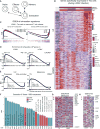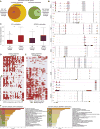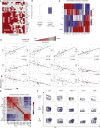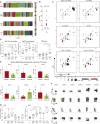Epigenomic-Guided Mass Cytometry Profiling Reveals Disease-Specific Features of Exhausted CD8 T Cells
- PMID: 29768164
- PMCID: PMC6010198
- DOI: 10.1016/j.immuni.2018.04.026
Epigenomic-Guided Mass Cytometry Profiling Reveals Disease-Specific Features of Exhausted CD8 T Cells
Abstract
Exhausted CD8 T (Tex) cells are immunotherapy targets in chronic infection and cancer, but a comprehensive assessment of Tex cell diversity in human disease is lacking. Here, we developed a transcriptomic- and epigenetic-guided mass cytometry approach to define core exhaustion-specific genes and disease-induced changes in Tex cells in HIV and human cancer. Single-cell proteomic profiling identified 9 distinct Tex cell clusters using phenotypic, functional, transcription factor, and inhibitory receptor co-expression patterns. An exhaustion severity metric was developed and integrated with high-dimensional phenotypes to define Tex cell clusters that were present in healthy subjects, common across chronic infection and cancer or enriched in either disease, linked to disease severity, and changed with HIV therapy. Combinatorial patterns of immunotherapy targets on different Tex cell clusters were also defined. This approach and associated datasets present a resource for investigating human Tex cell biology, with implications for immune monitoring and immunomodulation in chronic infections, autoimmunity, and cancer.
Keywords: CD8 T cell; CyTOF; HIV; T cell exhaustion; cancer immunology; chronic infection; immune checkpoint; lung cancer; mass cytometry; systems immunology.
Copyright © 2018 Elsevier Inc. All rights reserved.
Conflict of interest statement
E.J.W. has a patent licensing agreement on the PD-1 pathway. S.M.A. is the recipient of a sponsored research agreement from Janssen Pharmaceuticals. A provisional patent application has been filed based on work presented in this manuscript.
Figures







Comment in
-
Bigger and better in Tex's.Sci Immunol. 2018 Jun 1;3(24):eaau2260. doi: 10.1126/sciimmunol.aau2260. Sci Immunol. 2018. PMID: 29858288 Free PMC article.
References
Publication types
MeSH terms
Substances
Grants and funding
- R21 AI117718/AI/NIAID NIH HHS/United States
- F30 AI129263/AI/NIAID NIH HHS/United States
- U19 AI117950/AI/NIAID NIH HHS/United States
- T32 CA009140/CA/NCI NIH HHS/United States
- P30 AI045008/AI/NIAID NIH HHS/United States
- P30 CA008748/CA/NCI NIH HHS/United States
- U19 AI082630/AI/NIAID NIH HHS/United States
- P01 AI112521/AI/NIAID NIH HHS/United States
- R01 AI115712/AI/NIAID NIH HHS/United States
- P30 CA016520/CA/NCI NIH HHS/United States
- R01 AI105343/AI/NIAID NIH HHS/United States
- K08 AI114852/AI/NIAID NIH HHS/United States
- K12 CA076931/CA/NCI NIH HHS/United States
- T32 CA009615/CA/NCI NIH HHS/United States
- P01 AI108545/AI/NIAID NIH HHS/United States
LinkOut - more resources
Full Text Sources
Other Literature Sources
Medical
Research Materials

